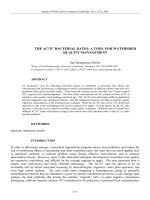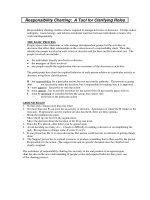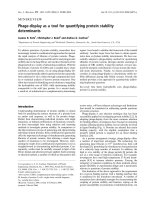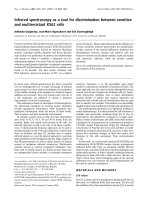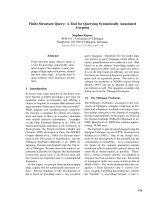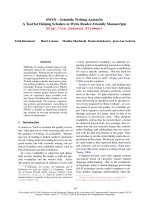Cluster frontline demonstrations: A tool for productivity enhancement and dissemination of technologies for Toria in Tirap district of Arunachal Pradesh, India
Bạn đang xem bản rút gọn của tài liệu. Xem và tải ngay bản đầy đủ của tài liệu tại đây (547.87 KB, 4 trang )
Int.J.Curr.Microbiol.App.Sci (2019) 8(5): 462-465
International Journal of Current Microbiology and Applied Sciences
ISSN: 2319-7706 Volume 8 Number 05 (2019)
Journal homepage:
Original Research Article
/>
Cluster Frontline Demonstrations: A Tool for Productivity
Enhancement and Dissemination of Technologies for
Toria in Tirap District of Arunachal Pradesh, India
Abhimanyu Chaturvedi* and D.S. Chhoker
Krishi Vigyan Kendra- Tirap, Arunachal Pradesh, India
*Corresponding author
ABSTRACT
Keywords
CFLDs,
Demonstrations,
Rainfed,
Technology
Article Info
Accepted:
07 April 2019
Available Online:
10 May 2019
In toria the low production and productivity of local varieties is considered as one of the
major constraints of traditional toria farming which has created gap between demand and
supply of edible oil. Krishi Vigyan Kendra- Tirap of the ICAR-ATARI, Zone-VI,
Guwahati conducted the Cluster Frontline Demonstration (CFLD) on oilseed to increase
productivity and farmer income in the 12 villages during 2017- 18. Thus, 12 villages of the
Tirap were selected to conduct the CFLDs on toria crop. For conducting the
demonstrations the farmers were guided to follow up the recommended and latest
technologies i.e. latest variety, seed treatment with bavistin and biofertilizer (Azatobacter)
and integrated crop management. For dissemination of these technologies, total 42
extension activities were conducted across the district of this in which 681 farmers actively
participated. Toria; variety TS-46 were demonstrated and it reported 51 per cent higher
yield over the local check in Tirap. CFLD on 50 ha with 125 number of demonstration
were allotted by ATARI, Zone- VI.
7-8 per cent ash. In India, per capita
consumption of vegetable oils is 13.36
kg/year/person, which is much lower than
USA (36 kg/year/person) and world (17
kg/year/person)
(Anonymous,
2015a).
Domestic consumption of edible oils has
increased substantially in India, over the
years, with increasing population and
improving purchasing power. It has touched
the level of 19.12 million tonnes during 2014
against the domestic availability of 9.00
million tones whereas 10.12 million tonnes of
edible oil requirement was fulfilled by
imports (Anonymous, 2015b). It indicates that
there is still a wide gap between edible oil
Introduction
Oilseed crop, the second major group among
agricultural crops after cereals, occupies an
important position in Indian agricultural
economy by virtue of its high fat content.
Among oilseed crops, rapeseed mustard and
toria is the third important group of oilseed
crops in the world after soybean and palm oil.
Vegetable oil constitutes an important part of
our daily diet being source of energy,
essential fatty acids and amino acids; while
rapeseed-mustard oil contains 38-40 per cent
crude protein, 12-13 per cent crude fibre and
462
Int.J.Curr.Microbiol.App.Sci (2019) 8(5): 462-465
production and actual demand; this deficit is
bridged through massive imports costing huge
amount of foreign exchange. The Government
decided to achieve self-sufficiency in edible
oilseeds production by various technological
interventions to overcome stagnant oilseed
production
through
promoting
latest
production technologies in oilseed production.
Government of India, again initiated
technology under National Mission on
Oilseeds and Oil Palm (NMOOP) by
providing funds during August 2017-18 to the
KVKs of ICAR-ATARI, Zone-VI, Guwahati
to increase oilseed production in this Zone
and achieve self-sufficiency in edible oils
production through CFLDs. The objectives of
CFLD was to demonstrate the improved
technologies among the famers recommended
by the State Agricultural Universities (SAUs)
and Indian Council of Agriculture Research
(ICAR) Institutes so that it would improve the
production and generate interest in the
growing of oilseed crops which is losing
importance due to stagnation in the yield
faced by farmers while executing the Cluster
demonstrations.
and productivity of the area. The CFLDs were
conducted in the farmer’s field in the district
so that the maximum number of farmers can
observe the demonstrations in the fields and
interest for cultivation of the crop can be
generated among the farmers as the main
objective of CFLDs is seeing in believing. So
a total of 125 demonstrations in an area of 50
hectares were conducted in Toria (variety: TS46) during rabi 2017-18 (Table 1).
Results and Discussion
The improved variety seed as input was
provided by the KVK to 125 farmers in 50
hectares areas along with the other essential
inputs included in the full package of
technologies were demonstrated. The list of
beneficiaries was prepared for conducting the
FLDs in selected blocks as given in Table 1;
and the technologies were provided by the
KVKs for Toria cultivation.
Farmers were guided to follow the
recommended practices as per provided by
the Assam Agricultural University- Jorhat.
The details of the FLDs conducted have been
given in Table 1. The basic inputs i.e.
improved variety of Toria, biofertilizers and
sulphur containing micronutrients were
provided to the farmers. Locally cultivated
varieties of Toria were used as local check
(Table 2).
Materials and Methods
The present investigations on CFLDs were
conducted during rabi 2017-18 by the KVK
Tirap of Arunachal Pradesh. The CFLD was
conducted
by demonstrating
selected
technology mainly to improve the production
Table.1 Details of FLDs on Toria
State
KVK
FLDs
No of Demos.
Arunachal
Tirap
125
Area (Ha)
50
Crop
Demonstrated
Variety
Technologies
TS-46
Pradesh
Blocks
Improved Variety,
Soha,
INM, Biofertilizer
Namsang,
(Azotobacter)
Khonsa,
Lawnu
463
Int.J.Curr.Microbiol.App.Sci (2019) 8(5): 462-465
Table.2 Details the result of Toria
KVK
Blocks
Tirap
Soha
Namsang
Khonsa
Lawnu
Average Yield (q/ha)
Demonstration
Check
10.72
6.87
8.54
6.21
9.43
7.16
10.98
7.69
% Increase
38.5
23.3
22.7
32.9
Table.3 Extension activities conducted during Rabi season, 2017-18
Extension Activities
Awareness Camp
Seed Distribution
Lecture Delivered
Method Demonstration
Field Visit
Farmers Scientist Interaction
Kisan Gosthi
Field Day
Total
No of Programmes
02
06
06
03
14
02
05
04
42
464
No of Farmers
56
125
148
24
57
39
89
141
681
Int.J.Curr.Microbiol.App.Sci (2019) 8(5): 462-465
The maximum increase in yield was recorded in
Soha block, 38.50 per cent higher over the local
check followed by Lawnu block (32.9 %). In
Namsang block, 23.3 per cent higher yield was
recorded as compared to local check, while the
minimum increase in yield reported in Khonsa
block (22.7 per cent). This percentage increase
in yield was due to demonstration of integrated
crop management technology e.g. seed
treatment
of
improved
variety
with
Azotobactor, application of sulphur fertilizer
and foliar spray of Potassium and Boron.
demonstrations following the principle of
“Seeing is believing”.
In conclusion, the results signify that the
production and productivity can be increased in
oilseed
production
through
Cluster
demonstrations by motivating the farmers for
the adoption of improved agro technologies
which were demonstrated in the CFLD plots.
But additional extension work is required to
decrease the gap between demand and supply.
However, soil moisture availability, rainfall
conditions, climatic aberrations, diseases
infestation and change in the location are also
responsible for disparity in yield of the crop.
Thus, technologies demonstrated under CFLDs
were helpful to improve the production,
productivity, farmer’s income as well as
increase in area under mustard crop.
Extension activities during cluster frontline
demonstrations
During CFLDs, a total of 42 extension activities
were conducted across the selected village of all
four blocks in which 681 numbers of farmers
actively participated (Table 3). The extension
activities comprised farmers-scientists interface, method demonstrations on scientific
practices, Kisan goshthis, trainings, etc. KVK
scientists usually visited farmers’ fields,
particularly to popularize oilseed cultivation in
the district. KVK scientists paid visits to
selected farmers where CFLDs on oilseeds were
demonstrated.
The
main
purpose
of
organization of field days was to disseminate
the improved technologies i.e. biofertilizers,
newly released variety etc. through the
References
Anonymous, 2015a. Major Features of Edible Oil
Economy. Oil division, Department of
Food and Public Distribution, Ministry of
Consumer Affairs, Food and Public
Distribution, Government of India.
Anonymous, 2015b. Commodity Profile of Edible
Oil. Department of Agriculture & Cooperation, Ministry of Agriculture,
Government
of
India.
How to cite this article:
Abhimanyu Chaturvedi and Chhoker, D.S. 2019. Cluster Frontline Demonstrations: A Tool for
Productivity Enhancement and Dissemination of Technologies for Toria in Tirap District of Arunachal
Pradesh, India. Int.J.Curr.Microbiol.App.Sci. 8(05): 462-465.
doi: />
465


